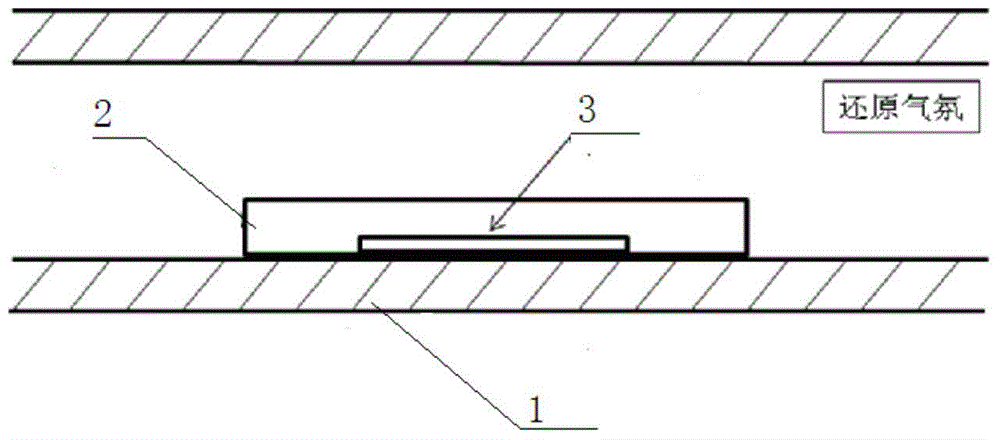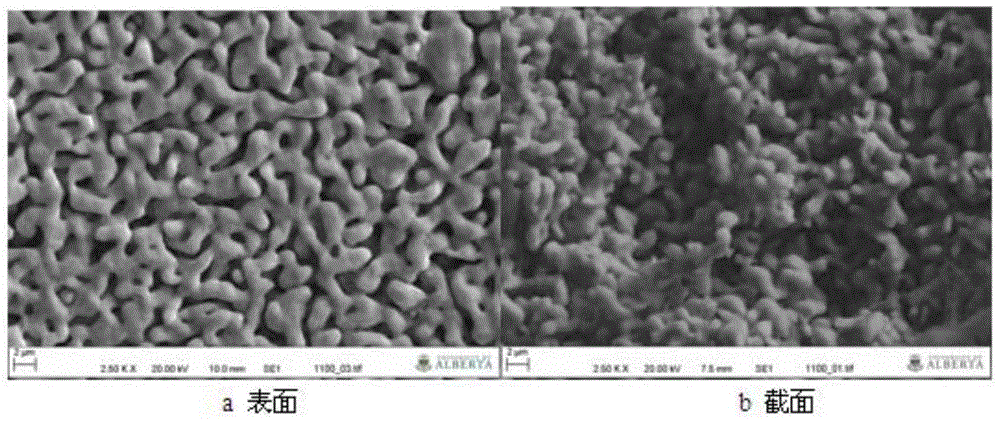Method for preparing porous chromium carbide by using reaction sintering process
A chromium carbide and process technology, applied in the field of porous carbide preparation, can solve the few problems such as porous chromium carbide preparation process, and achieve the effects of strong operability and controllability, low cost, and simple process equipment
- Summary
- Abstract
- Description
- Claims
- Application Information
AI Technical Summary
Problems solved by technology
Method used
Image
Examples
Embodiment 1
[0027] Step 1. Preparation of the ceramic body:
[0028] The raw material for the preparation of the ceramic body is chromium oxide powder. The original chromium oxide powder is added to alumina balls and ground by a ball mill for 10 hours until uniform, and then 15wt. The final powder is pressed into an embryo body by cold isostatic pressing in a mold specially made by the manufacturer for subsequent use; wherein, the pressure of the cold isostatic pressing is 20MPa;
[0029] Step 2. Preparation of porous ceramics:
[0030] The green body prepared in step 1 is placed in a vacuum tube furnace for pre-sintering. The pre-sintering is to sinter the ceramic green body at a temperature of 150°C in air for one hour and then raise the temperature to 1000°C for another 2 hours;
[0031] Then feed methane 10% + argon 40% + H into the vacuum tube furnace at a flow rate of 40 ml / min 2 A mixed gas with a composition of 50% was sintered at a temperature of 1000°C for 10 hours to obtain a...
Embodiment 2
[0033] Step 1. Preparation of the ceramic body:
[0034] The raw material for the preparation of the ceramic body is chromium oxide powder. The original chromium oxide powder is added to alumina balls and ground by a ball mill for 10 hours until uniform, and then 10 wt. The final powder is pressed into an embryo body by means of cold isostatic pressing in a mold specially made by the manufacturer for subsequent use; wherein, the pressure of said cold isostatic pressing is 100MPa;
[0035] Step 2. Preparation of porous ceramics:
[0036] The green body prepared in step 1 is placed in a vacuum tube furnace for pre-sintering. The pre-sintering is to sinter the ceramic green body at a temperature of 150°C in air for one hour and then raise the temperature to 1000°C for another 2 hours;
[0037] Then, methane 20% + argon 30% + H was introduced into the vacuum tube furnace at a flow rate of 60 ml / min. 2 A mixed gas with a composition of 50% was sintered at a temperature of 1200°C ...
Embodiment 3
[0039] Step 1. Preparation of the ceramic body:
[0040] The raw material for the preparation of the ceramic body is chromium oxide powder. The original chromium oxide powder is added to alumina balls and ground by a ball mill for 10 hours until uniform, and then 5wt. The final powder is pressed into an embryo body by the method of cold isostatic pressing in a mold specially made by the manufacturer for subsequent use; wherein, the pressure of the cold isostatic pressing is 200MPa;
[0041] Step 2. Preparation of porous ceramics:
[0042] The green body prepared in step 1 is placed in a vacuum tube furnace for pre-sintering. The pre-sintering is to sinter the ceramic green body at a temperature of 150°C in air for one hour and then raise the temperature to 1000°C for another 2 hours;
[0043]Then, a mixed gas consisting of 15% methane + 35% argon + 50% hydrogen was introduced into the vacuum tube furnace at a flow rate of 80 ml / min, and sintered at a temperature of 1300°C for...
PUM
| Property | Measurement | Unit |
|---|---|---|
| hardness | aaaaa | aaaaa |
| pore size | aaaaa | aaaaa |
| pore size | aaaaa | aaaaa |
Abstract
Description
Claims
Application Information
 Login to View More
Login to View More - R&D
- Intellectual Property
- Life Sciences
- Materials
- Tech Scout
- Unparalleled Data Quality
- Higher Quality Content
- 60% Fewer Hallucinations
Browse by: Latest US Patents, China's latest patents, Technical Efficacy Thesaurus, Application Domain, Technology Topic, Popular Technical Reports.
© 2025 PatSnap. All rights reserved.Legal|Privacy policy|Modern Slavery Act Transparency Statement|Sitemap|About US| Contact US: help@patsnap.com



